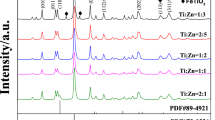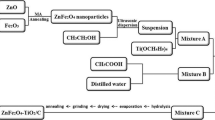Abstract
In this work, g-C3N4/TiO2 nanocatalysts were prepared by high-voltage electrospinning and hydrothermal methods. The surface of the pure TiO2 nanomaterial was treated by acidification before it was combined with g-C3N4.Various characterization methods were used to characterize the prepared photocatalyst. RhB (20 mg/L) was degraded as a target-degradable pollutant, the degradation efficiency of the nanocatalyst was measured under UV–Visible light. The results show that the degradation efficiency of the g-C3N4/TiO2 nanocomposite material that has undergone pre-acidification treatment is much higher than that of the untreated catalyst.






Similar content being viewed by others
References
J. Wei et al., Effect of oil on the morphology and photocatalysis of emulsion electrospun titanium dioxide nanomaterials. Appl. Catal. A Gen. 499, 101–108 (2015)
Y. Zhang, T. Wang, M. Zhou, Y. Wang, Z. Zhang, Hydrothermal preparation of Ag-TiO2 nanostructures with exposed 001}/{101 facets for enhancing visible light photocatalytic activity. Ceram. Int. 43, 3118–3126 (2017)
H. Shi et al., Highly porous SnO2/TiO2 electrospun nanofibers with high photocatalytic activities. Ceram. Int. 40, 10383–10393 (2014)
T. Wang et al., g-C3N4 composited TiO2 nanofibers were prepared by high voltage electrostatic spinning to improve photocatalytic efficiency. J. Mater. Sci. Mater. Electron. (2020). https://doi.org/10.1007/s10854-020-04890-7
H. Guo et al., Steering exciton dissociation and charge migration in green synthetic oxygen-substituted ultrathin porous graphitic carbon nitride for boosted photocatalytic reactive oxygen species generation. Chem. Eng. J. 385, 123919 (2020)
Z. Huang et al., Effect of contact interface between TiO2 and g-C3N4 on the photoreactivity of g-C3N4/TiO2 photocatalyst: (001) vs (101) facets of TiO2. Appl. Catal. B Environ. 164, 420–427 (2015)
H. Bashir, X. Yi, J. Yuan, K. Yin, S. Luo, Highly ordered nanotube arrays embedded with nanorods for enhanced photocatalytic activity. J. Photochem. Photobiol A: Chem 382, 111930 (2019)
K. Hu, R. Li, C. Ye, A. Wang, W. Wei, D. Hu, R. Qiu, K. Yan, Facile synthesis of Z-scheme composite of nanorod/nanosheet efficient for photocatalytic degradation of ciprofloxacin. J. Clean. Prod. J. 253, 120055 (2020)
J. Fan, E.-Z. Liu, L. Tian, X.-Y. Hu, Q. He, T. Sun, Synergistic effect of N and Ni2+ on nanotitania in photocatalytic reduction of CO2. J. Environ. Eng. 137, 171–176 (2011)
L. Sun, X. Zhao, X. Cheng, H. Sun, L. Yanlu, P. Li, W. Fan, Synergistic effects in La/N codoped TiO2 anatase (101) surface correlated with enhanced visible-light photocatalytic activity. Langmuir 28, 5882–5891 (2012)
J. Huang et al., One-step synthesis of phosphorus/oxygen co-doped g-C3N4/anatase TiO2 Z-scheme photocatalyst for significantly enhanced visible-light photocatalysis degradation of enrofloxacin. J. Hazard. Mater. 386, 121634 (2020)
Y. Huang et al., Protonated g-C3N4/Ti3+ self-doped TiO2 nanocomposite films: room-temperature preparation, hydrophilicity, and application for photocatalytic NOx removal. Appl. Catal. B Environ. 240, 122–131 (2019)
P. Kumar, P. Kar, A.P. Manuel, S. Zeng, U.K. Thakur, K.M. Alam, Y. Zhang, R. Kisslinger, K. Cui, G.M. Bernard, V.K. Michaelis, Visible light driven photocatalysis using nanotube arrays sensitized by P-doped C3N4 quantum dots. Adv. Optic. Mater. 1901275, 1–15 (2019)
P. Kumar, U. Kumar, K. Alam, P. Kar, R. Kisslinger, S. Zeng, S. Patel, K. Shankar, Arrays of nanorods embedded with fluorine doped carbon nitride quantum dots (CNFQDs) for visible light driven water splitting. Carbon 137, 174–187 (2018)
W. Wang, Q. Niu, G. Zeng, C. Zhang, D. Huang, 1D porous tubular capture black phosphorus quantum dots as 1D/0D metal-free photocatalysts for oxytetracycline hydrochloride degradation and hexavalent chromium reduction. Appl. Catal. B: Environ. 273, 119051 (2020)
J. Wu, Y. Feng, D. Li, X. Han, J. Liu, Efficient photocatalytic CO2 reduction by PeO linked /-nanotubes Z-scheme composites. Energy 178, 168–175 (2019)
J. Yu, Q. Li, S. Liu, M. Jaroniec, Ionic-liquid-assisted synthesis of uniform fluorinated B/C-codoped TiO2 nanocrystals and their enhanced visible-light photocatalytic activity. Chem. Eur. J. 19, 2433–2441 (2013)
P. Simon, B. Pignon, B. Miao, S. Coste-Leconte, Y. Leconte, S. Marguet, P. Jegou, B. Bouchet-Fabre, C.C. Reynaud, N. Herlin-Boime, N-doped titanium monoxide nanoparticles with TiO2 rock-salt structure, low energy band gap, and visible light activity. Chem. Mater. 22, 3704–3711 (2010)
V.C. Stengl, V. Houskova, S. Bakardjieva, N. Murafa, Photocatalytic activity of boron-modified titania under UV and visible-light illumination. ACS Appl. Mater. Interfaces 2, 575–580 (2010)
P. Kumar et al., Noble metal free, visible light driven photocatalysis using TiO2 nanotube arrays sensitized by P-doped C3N4 quantum dots. Adv. Opt. Mater. 8, 1901275 (2020)
G. Marotta, M.G. Lobello, C. Anselmi, G. Barozzino-Consiglio, M. Calamante, A. Mordini, M. Pastore, F. De Angelis, An integrated experimental and theoretical approach to the spectroscopy of organic-dye-sensitized heterointerfaces: disentangling the effects of. ChemPhysChem 15, 1116–1125 (2014)
E. Ronca, G. Marotta, M. Pastore, F.D. Angelis, Effect of sensitizer structure and protonation on charge generation in dye-sensitized solar cells. Indian J. Chem. Sect. A 118, 16927 (2014)
J.R. Swierk, N.S. Mccool, T.P. Saunders, G.D. Barber, T.E. Mallouk, Effects of electron trapping and protonation on the efficiency of water-splitting dye-sensitized solar cells. J. Am. Chem. Soc. 136(31), 10974–10982 (2014)
S.K. Park, H. Shin, Effect of HCl and H2SO4 treatment of powder on the photosensitized degradation of aqueous. J. Nanosci. Nanotechnol. 14, 8122–8128 (2014)
Z. Wang, T. Yamaguchi, H. Sugihara, Significant efficiency improvement of the black dye-sensitized solar cell through protonation of films. Langmuir 5, 4272–4276 (2005)
Z. Wang, G. Zhou, Effect of surface protonation of on charge recombination and conduction band edge movement in dye-sensitized solar cells. J. Phys. Chem. C 113, 15417–15421 (2009)
J. Li, M. Zhang, Q. Li, J. Yang, Enhanced visible light activity on direct contact Z-scheme g-C3N4-TiO2 photocatalyst. Appl. Surf. Sci. 391, 184–193 (2017)
X. Li, J. Xiong, Y. Xu, Z. Feng, J. Huang, Defect-assisted surface modification enhances the visible light photocatalytic performance of g-C3N4@C-TiO2 direct Z-scheme heterojunctions. Cuihua Xuebao/Chin. J. Catal. 40, 424–433 (2019)
J. Yu, S. Wang, J. Low, W. Xiao, Enhanced photocatalytic performance of direct Z-scheme g-C3N4/TiO2 photocatalyst for decomposition of formaldehyde in air. Phys. Chem. Chem. Phys. 15, 16883–16890 (2013)
S. Kumar, A. Baruah, S. Tonda, B. Kumar, V. Shanker, B. Sreedhar, Cost-effective and eco-friendly synthesis of novel and stable N-doped ZnO/g-C3N4 core-shell nanoplates with excellent visible-light responsive photocatalysis. Nanoscale 6, 4830–4842 (2014)
Y. Si, Z. Sun, L. Huang, M. Chen, L. Wu, A ‘ship-in-a-bottle’ strategy to fabricate highly crystallized nanoporous graphitic g-C3N4 microspheres under pressurized conditions. J. Mater. Chem. A 7, 8952–8959 (2019)
L.C. Sim et al., In situ growth of g-C3N4 on TiO2 nanotube arrays: construction of heterostructures for improved photocatalysis properties. J. Environ. Chem. Eng. 8, 103611 (2020)
Z. Sun, S. Fang, Y.H. Hu, 3D graphene materials: from understanding to design and synthesis control. Chem. Rev. 120, 10336–10453 (2020)
M.B. Tahir, M. Sagir, K. Shahzad, Removal of acetylsalicylate and methyl-theobromine from aqueous environment using nano-photocatalyst WO3-TiO2 @g-C3N4 composite. J. Hazard. Mater. 363, 205–213 (2019)
L. Yang et al., Co3O4 imbedded g-C3N4 heterojunction photocatalysts for visible-light-driven hydrogen evolution. Renew. Energy 145, 691–698 (2020)
J. Yu, J. Zou, P. Xu, Q. He, Three-dimensional photoelectrocatalytic degradation of the opaque dye acid fuchsin by Pr and Co co-doped TiO2 particle electrodes. J. Clean. Prod. 251, 119744 (2020)
Z. Zafar, I. Ali, S. Park, J.O. Kim, Effect of different iron precursors on the synthesis and photocatalytic activity of Fe–TiO2 nanotubes under visible light. Ceram. Int. 46, 3353–3366 (2020)
C. Zhou et al., Distorted polymeric carbon nitride via carriers transfer bridges with superior photocatalytic activity for organic pollutants oxidation and hydrogen production under visible light. J. Hazard. Mater. 386, 121947 (2020)
R. Hao, G. Wang, H. Tang, L. Sun, C. Xu, D. Han, Template-free preparation of macro/mesoporous g-C3N4 /TiO2 heterojunction photocatalysts with enhanced visible light photocatalytic activity. Appl. Catal. B: Environ. 187, 47–58. https://doi.org/10.1016/j.apcatb.2016.01.026 (2016)
L. Ma, G. Wang, C. Jiang, H. Bao, Q. Xu, Synthesis of core-shell TiO2 @g-C3 N4 hollow microspheres for efficient photocatalytic degradation of rhodamine B under visible light. Appl. Surface Sci. 430, 263–272. https://doi.org/10.1016/j.apsusc.2017.07.282 (2018)
K. Li, Z. Huang, X. Zeng, B. Huang, S. Gao, J. Lu, Synergetic Effect of Ti3+ and oxygen doping on enhancing photoelectrochemical and photocatalytic properties of TiO2/g-C3N4 heterojunction. ACS Appl. Mat. Interfaces 9(13), 11577–11586 https://doi.org/10.1021/acsami.6b16191 (2017)
R. Hao, G. Wang, C. Jiang, H. Tang, Q. Xu, In situ hydrothermal synthesis of g-C3N4/TiO2 heterojunction photocatalysts with high specific surface area for Rhodamine B degradation. Appl. Surface Sci. 411, 400–410. https://doi.org/10.1016/j.apsusc.2017.03.197 (2017)
L. Hu, J. Yan, C. Wang, B. Chai, J. Li, Direct electrospinning method for the construction of Z-scheme TiO2/g-C3N4/RGO ternary heterojunction photocatalysts with remarkably ameliorated photocatalytic performance. Chinese J. Catal. 40(3), 458–469 https://doi.org/10.1016/S1872-2067(18)63181-X (2019)
Z. Lu, L. Zeng, W. Song, Z. Qin, D. Zeng, C. Xie, In situ synthesis of C-TiO2/g-C3N4 heterojunction nanocomposite as highly visible light active photocatalyst originated from effective interfacial charge transfer. Appl. Catal. B: Environ. 202, 489–499 https://doi.org/10.1016/j.apcatb.2016.09.052 (2017)
Author information
Authors and Affiliations
Corresponding author
Additional information
Publisher's Note
Springer Nature remains neutral with regard to jurisdictional claims in published maps and institutional affiliations.
Rights and permissions
About this article
Cite this article
Wang, T., Sun, T., Xu, J. et al. The pre-acidizing corrosion on the surface of TiO2 enhanced the photocatalytic activity of g-C3N4/TiO2. J Mater Sci: Mater Electron 32, 21083–21092 (2021). https://doi.org/10.1007/s10854-021-06608-9
Received:
Accepted:
Published:
Issue Date:
DOI: https://doi.org/10.1007/s10854-021-06608-9




